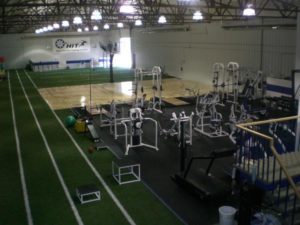by Chad Englehart Introduction
 Specificity of Training principle is one of the most utilized training principles used by exercise professionals today. (Kramer et al., 2002) discussed the principle of training specificity and explained that the training responses elicited by a given exercise mode are directly related to the physiological elements involved with coping with the specific exercise stress. What this means is that if an athlete wants to perform better at a particular event or skill they must train specifically for that particular skill. For example, if an athlete wants to become stronger one must lift heavy weights and if an athlete wants to jump higher one must jump. As a strength and conditioning professional one must know if the movement patterns as well as the methods of the training will lead to neuromuscular or metabolic training adaptations to their specific sport. This goes back to an important rule of coaching which is, "Know your athletes." This is important because if a strength and speed coach wants to work on a vertical jump for a 15 year old female volleyball player and she does not have the lower body strength to handle the eccentric load of landing or she does not know how to land she could injure herself. Therefore, before training specifically to enhance particular sports movements always evaluate the athlete first. The principle of specificity is also important for Strength and Speed coaches when designing strength and speed programs to their particular sport. The coach must know the type neuromuscular adaptations the athletes need during the particular time of the year whether; it is off-season, pre-season or in-season this is important because as a coach, one does not want to stress the neuromuscular system. Ronnie McKeefey Head Strength and Conditioning Coach for The University of South Florida believes that sport specificity goes too far when exercises that are prescribed place undue orthopedic stress on the body and are not principled based. He goes on to explain that there must be more exercise than just trying to mimic sport movements while under load (2). Specificity is important principle in all of these training modules because the exercise or training protocol must be specific to the type of action required so that the body is neuromuscular adapted to the particular demands of the type of training.
Specificity of Training principle is one of the most utilized training principles used by exercise professionals today. (Kramer et al., 2002) discussed the principle of training specificity and explained that the training responses elicited by a given exercise mode are directly related to the physiological elements involved with coping with the specific exercise stress. What this means is that if an athlete wants to perform better at a particular event or skill they must train specifically for that particular skill. For example, if an athlete wants to become stronger one must lift heavy weights and if an athlete wants to jump higher one must jump. As a strength and conditioning professional one must know if the movement patterns as well as the methods of the training will lead to neuromuscular or metabolic training adaptations to their specific sport. This goes back to an important rule of coaching which is, "Know your athletes." This is important because if a strength and speed coach wants to work on a vertical jump for a 15 year old female volleyball player and she does not have the lower body strength to handle the eccentric load of landing or she does not know how to land she could injure herself. Therefore, before training specifically to enhance particular sports movements always evaluate the athlete first. The principle of specificity is also important for Strength and Speed coaches when designing strength and speed programs to their particular sport. The coach must know the type neuromuscular adaptations the athletes need during the particular time of the year whether; it is off-season, pre-season or in-season this is important because as a coach, one does not want to stress the neuromuscular system. Ronnie McKeefey Head Strength and Conditioning Coach for The University of South Florida believes that sport specificity goes too far when exercises that are prescribed place undue orthopedic stress on the body and are not principled based. He goes on to explain that there must be more exercise than just trying to mimic sport movements while under load (2). Specificity is important principle in all of these training modules because the exercise or training protocol must be specific to the type of action required so that the body is neuromuscular adapted to the particular demands of the type of training.
Resistance Training for Specific Outcomes
Research Finding and Specificity As professionals coaches understand that explosive Olympic lifting and other forms of weight training will help athletes on the field however, many coaches feel that a sprint training program should also include strength specific exercises like sled sprints or weighted sprints. Young, W., Grant, D., and Pryor, J., (2001) did a study on resistance training for short sprints and maximum-speed sprints and found that the quadriceps muscles were important for short sprints and the hamstrings were more important for maximum sprinting. They go on to explain some specificity exercises for sprinting, for the short sprints 10 meter or less the exercises are sled sprints and inclined sprints both from static standing starts. The maximum speed exercise were speed bounding and weighted vest sprinting. As strength and conditioning professional these are great specific exercises to help become a faster athlete. The short sprint exercises really target the quadriceps and glutes, helps with stride frequency and helps increase the force on the motor units. The max speed exercises target the hamstrings, helps with stride length and helps increase the rate of the motor units. This is a great specificity example for speed because through this specificity training an athlete has increased the size and force of the motor unit as well as the rate at which the motor unit fires which in turn with proper mechanics should make the athlete a faster runner. Alcaraz, P., Palao, J., Elvira, J., and Linthorne, N., (2008) also did a study on resistance sprinting but they wanted to find out more specifically the effects of three different types of resisted sprint training on the kinematics of sprinting at maximum velocity. They used three types of resisted sprint training devices which were a sled, parachute, and weighted belt to compare sprinting kinematics during maximum velocity. What they found was that all three types were appropriate training for the maximum velocity phase of sprinting and only induced minor changes in the athletes running technique.
These two studies are great examples on the specificity principle they show if an athlete's wants to get faster than the athlete must sprint to become faster. Another athletic movement that we train specifically is the vertical jump. Although as professionals one knows that resistance training and explosive training can get you stronger but if an athlete wants to jump higher than they must train using plyometrics. McClenton, L., Brown, J., Coburn, J., and Kersey, R., (2008) did a short term study on the Verti-max vs. Depth jump training and its effect on vertical performance. The verti-max is a training apparatus that uses rubber bands and a pulley system that fully loads the athlete in the low squat position, and then maintains this same level of resistance all the way to the top of the jump. The depth jump is a plyometric exercise that rapidly utilizes the stretch shortening cycle. This exercise consists on stepping off a box landing with both feet, then jumping off the ground as fast and as high as possible. During this six week study they found that the verti-max had no improvement on the vertical jump and the depth jump had significant improvement. Both are very good specific exercises but the verti-max costs nearly $2,000.00 and for the depth jump all an athlete needs is a box. The depth jump also in my opinion is a better exercise if strong enough because of the rapid eccentric movements which in turn causes a rapid concentric movement. Wagner, DR and Kocak, MS (1997) explains that the faster a muscle is stretched the greater the force production and the more powerful the muscle action; which, explains why the depth jump is a more efficient exercise when coached and performed properly. Resistance training is one of the most important aspects to the specificity principle. There are many types of possible outcomes in resistance training; which include endurance, hypertrophy, strength, and power. As strength and conditioning professionals one must know what to train for and at what time of the year to train for the particular outcome. Behm, D. (1995) did a study on the neuromuscular implications and applications of resistance training specifically on strength and power training. This study explained that the high rate of force development achieved with ballistic contractions should serve as a template for power training; and that muscle hypertrophy is dependent upon protein degradation and synthesis, which may be enhanced through high intensity, high volume eccentric work and concentric contractions. One of the most interesting parts of this research was the part on power training. Behm believes that the high-speed training may increase the rate of force development through an increase in the firing frequency or the motor units. He goes on to explain that to guarantee high-specific adaptations in a power training program the speed of the contraction must be high and that the movement speed is not essential as long as the intent of the contraction is explosive. Saltin and Gollnick (1983) showed through their research that with endurance training, muscle fibers shift towards a slow profile thus allowing those muscles fibers to increase their endurance capacity. Staron, Malickly, Leonardi, Falkel, Hagerman, and Dudley (1990) did a study on muscle hypertrophy and fast fiber types in heavy resistance-trained women and found that heavy resistance training results in a shifting of the rarely used fast twitch B fibers to heavily used fast twitch A fibers; which, allow more fibers to be called upon to produce force for faster and more forceful explosive movements. This type of research on resistance training shows that if an athlete requires muscular endurance, strength, size or explosiveness there are specific training patterns. The strength and conditioning professional must follow the specific training protocols to ensure that the neuromuscular system is adapting to the training properly so that the athletes body can perform better in his or her sport.
Balancing Specificity and Versatility: The Key to Effective Athletic Training
Conclusion In closing, Zatsiorsky (1995) explains that the training principle on specificity is well accepted and suggests that for training to be effective, it should be similar to the demands of the sport. Usually, the more specific the training, the better the transfer to sports performance. All though that last statement may be true, many strength and conditioning professionals including myself believe non-specific training should also take place in a training program not only to achieve a higher level of ability but for also injury prevention. Keep in mind, training first started to prevent injury and later professionals discovered that training can also improve performance. Finally, as a strength and conditioning professional one must know the performance goals of the sport which will help the professional dictate the type of training for the athlete or team; and while every possible type of sports movement cannot be simulated in the weight room, there are other non-specific sports movements and exercises that will stimulate the neuromuscular system which will help athletes when they go into competition.
References
- Behm, D.G. Neuromuscular Implications and Applications of Resistance Training. Journal of Strength & Conditioning Research. 9(4): 264-274. 1995.
- Bennett, Scott. Sport Specificity: How far Do you take it? Strength and Conditioning Journal. 28(4): 29-30. 2006.
- Eduardo Sáez Sáez, González-Badillo, Juan Jose, Izquierdo, Mike .Low and Moderate Plyometric Training Frequency Produces Greater Jumping and Sprinting Gains Compared with High Frequency. Journal of Strength and Conditioning Research. 22(3): 715-725. 2008.
- Kramer, JF, Morrow, A, and Leger, A. Changes in rowing ergometer, weight lighting, vertical jump and isokinetic performance in response to standard and standard plus plyometric training programs. Int J Sports Med 14: 449-454, 1983.
- McClenton, L., Brown, Lee, Coburn, J., Kersey, R., The Effect of Short-Term VertiMax vs. Depth Jump Training on Vertical Jump Performance. Journal of Strength & Conditioning Research. 22(2): 321-325. 2008.
- Saltin B and Gollnic PD. Skeletal muscle adaptability: Significance for metabolism and performance. In Handbook of Physiology (eds. L. Peachy, R. Adrian, and SR Gerzer). American Physiological Society: Bethesda, MD, 555-631, 1983.
- Staron RS, Malicky ES, Leonardi MJ, Falkel JE, Hagerman FC, and Dudley GA. Muscle hypertrophy and fast fiber type conversions in heavy resistance –trained women. European Journal of Applied Physiology and Occupational Physiology 60, 71-79, 1990
- Wagner, DR and Kocak, MS. A multivariate approach to assessing anaerobic power following a plyometric training program. Journal of Strength & ConditioningResearch.11: 251-255, 1997.
- Young, Warren PhD, Benton, Dean, Pryor, John,. Resistance Training for Short Sprints and Maximum-speed Sprints. Strength & Conditioning Journal. 23(2): 7-13. 2001.
- Zatsiorsky, V.M. Science and Practice of Strength Training. Champaign. IL: Human Kinetics, 1995.




Trackbacks/Pingbacks